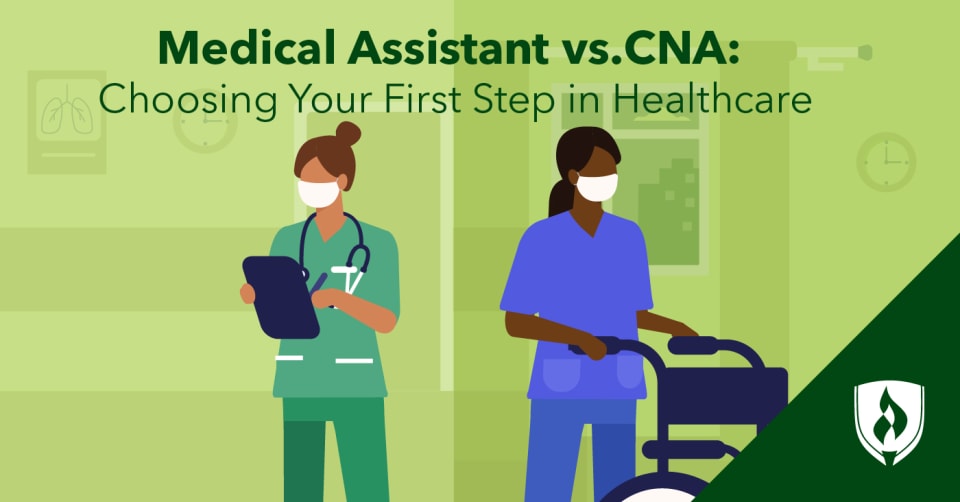Medical Assistant vs. CNA: Choosing Your First Step in the Healthcare Field
By Carrie Mesrobian on 01/24/2022

The healthcare field has been calling your name. Every time you’re at the doctor, you wonder what it’d be like to be the one wearing scrubs, assisting doctors and helping patients. Lately, that call has gotten too strong to ignore. You’re ready to stop daydreaming and start narrowing down your options for healthcare careers.
Committing to at least an associate’s degree to become a registered nurse sounds like too much for you right now. Luckily, there are plenty of other entry-level healthcare jobs to get your foot in the door of this satisfying field—you just might not know the difference between them. Two of those potentially confusing job titles are medical assistant (MA) and certified nursing assistant (CNA).
Deciding between a medical assistant versus a CNA career doesn’t have to be difficult. We’re breaking down the differences between these vital healthcare roles so you can take your vision further and choose the best healthcare position for your skills and interests. Keep reading to learn all the ins and outs of a medical assistant versus a CNA job.
Medical assistant vs. CNA: Job duties
Medical assistants enjoy the best of both worlds in healthcare facilities as they move between direct patient care and administrative tasks.
On the patient care side, their job duties typically include taking vital signs, administering shots and medication, preparing blood samples for lab testing and helping physicians complete exams. On the administrative side, you can find MAs scheduling appointments and keeping patient records up to date with correct family history and new information from the visit.
CNAs, on the other hand, work directly with patients all the time. They have less of a hand in traditional medical duties and instead focus on helping patients with basic care in hospitals or nursing homes.
Their job duties include helping patients get dressed, bathe or shower, eat their meals and transfer between a bed and a wheelchair. They also take patients’ vital signs and communicate their patients’ health concerns to nurses.
Medical assistant vs. CNA: Work environments
Medical assistants are most likely to be found in a clinic setting, with 57 percent working in physicians’ offices, according to the Bureau of Labor Statistics (BLS).1 Only 15 percent work in hospitals and the remainder can be found in outpatient facilities or chiropractors’ offices.1 Because many of these healthcare locations maintain daytime hours only, MAs are less likely to be scheduled to work overnight shifts or during holidays.
A CNA’s work of providing day-to-day care makes them a valuable part of any healthcare facility where patients may need to stay long-term. The BLS reports that many CNAs work in nursing care facilities (37 percent) or assisted living facilities (11 percent).1 A smaller percentage work in home healthcare. They’re also more likely to work in hospitals than MAs. The valuable care CNAs provide is needed around the clock, so they’re more likely to have a schedule with overnight, weekend and holiday shifts.
Medical assistant vs. CNA: Skills needed
You know that entering the healthcare field means learning new technical and medical skills. We analyzed real-time job postings to uncover the top skills employers are looking for in these two important professions.
Top skills for medical assistants:2
- Appointment scheduling
- Vital signs measurement
- Cardiopulmonary resuscitation (CPR)
- Injections
- Electrocardiogram (EKG)
Top skills for CNAs:3
- Activities of daily living (ADLs) assistance
- Patient bathing
- Vital signs measurement
- Home health assistance
The BLS adds that MAs may benefit from being detail-oriented and having analytical skills that will assist them in maintaining patient charts and other administrative duties.1 CNAs, on the other hand, do well with strong communication skills and the physical stamina required to adequately care for their patients.1
Medical assistant vs. CNA: Job outlook
Medical assistants can expect job opportunities to grow much faster than the national average for all occupations. Due to the aging baby boomer population, the BLS projects employment for this healthcare job to grow by 18 percent from 2020 to 2030.1 This is more than double the national average of eight percent growth.
CNAs also fare well when it comes to job outlook, with a projected employment growth of 8 percent from 2020 through 2030, according to the BLS.1
Medical assistant vs. CNA: Education requirements
Though MAs and CNAs are both essential to patient care, you won’t need a four-year degree to get started in one of these careers.
Medical assistants aren’t required to have a postsecondary degree, though the BLS notes that employers may prefer candidates who have gone through an MA training program. These programs teach medical terminology and anatomy that provide a solid foundation for a healthcare career.
It may be in your best interest to have some schooling under your belt before you pursue becoming an MA. The good news is, earning a Medical Assisting Diploma can take as few as 12 months to complete, allowing you to embark on your new healthcare career sooner rather than later.4
If you’ve got your eye on becoming a CNA, you will have to become certified—it’s right there in the job title! The first step is to learn the basics of patient care at a state-approved program and then gain experience through clinical work, according to the BLS. Once your education is complete, you officially become a CNA by passing a state-mandated competency exam. Some states may also have additional requirements, like passing a background check or completing continuing education.
The choice is yours
You’ve seen the full rundown of what it means to be a medical assistant versus a CNA. Now it’s up to you to decide which of these career paths could be your first step into the world of healthcare.
If you'd like to know more about becoming a CNA, check out our article "What Is a CNA? The Perfect First Step for Aspiring Nurses."
If you feel a career as a medical assistant is right for you, you’ll get more details in “How to Become a Medical Assistant: 5 Steps You Can’t Ignore.”
Related Articles:
1Bureau of Labor Statistics, U.S. Department of Labor, Occupational Outlook Handbook, [information accessed December 2021] www.bls.gov/ooh/. Data represents national, averaged earnings for the occupations listed and includes workers at all levels of education and experience. Employment conditions in your area may vary.
2Burning-Glass.com (analysis of 270,219 medical assistant job postings, November 01, 2020 – October 31, 2021).
3Burning-Glass.com (analysis of 389,629 nursing assistant job postings, November 01, 2020 – October 31, 2021).
4Completion time is dependent on transfer credits accepted and courses completed each term.
EDITOR’S NOTE: This article was originally published in 2018. It has since been updated to include information relevant to 2022.




